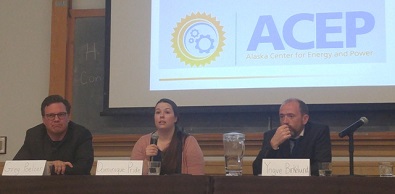Members from the U of S, Alaska and Norway discuss sustainable energy for the future. Photo courtesy of Dean Bear.
Lessening the burden on traditional power generation was the focus of a panel discussion at the University of Saskatchewan, which included international guests from Norway, Sweden and Alaska. Nordic countries have been leading the way when it comes to alternative energy sources other than coal, nuclear power and diesel fuel.
In Sweden, nuclear power plants are being phased out in favour of wind power and biomass generation, which is generated from renewable organic waste that would otherwise be dumped in landfills, openly burned, or left as fodder for forest fires.
In Saskatchewan, a majority of power generated comes from coal plants, natural gas and hydroelectric dams, with more wind farms becoming commonplace on the prairie horizon.
Greg Poelzer is with the Department of Environment and Sustainability at the University of Saskatchewan, which hosted the panel on sustainable power. He says Saskatchewan and northern Saskatchewan in particular have great opportunities when it comes to sustainable power development. He says northern communities could become independent power producers and sell produced power back to SaskPower.
“Some of the lessons we can learn from places like Norway and Sweden is the north can do things. We can do hydro, wind, biomass generation and we can do solar,” he says. He added that Aboriginal people can be on the forefront in ways similar to Alaska.
In Alaska, 57 Indigenous communities have banded together to form the Alaska Village Electric Cooperative. It uses traditional diesel generators and powerhouses to fuel the communities, but has also tapped into wind power to help those in rural areas access reliable electricity. Poelzer says the same can be done in Saskatchewan.
“Our communities can create micogrids at the community level, whether it’s at Pelican Narrows or Fond-du-Lac, and used their own energy sources like run-off river hydro, solar or biomass, and be tied to that grid is a massive advantage for northern Saskatchewan,” he said.
Saskatchewan has some hefty targets of wanting to reach a goal of fifty per cent of the electricity it produces come from renewable energy by the year 2030. While Poelzer says those are lofty goals to producing green energy, he also points out that green energy is only good energy when it is done properly.
“When companies look at doing large-scale projects, then you have to work with communities for proper consultation,” he said.
Poelzer says northern communities have taken steps already to become leaders in power generation. He points to the Tazi Twe project at Black Lake that has been put on hold for the time being due to less demand for power from the mining sector.
“Commodity prices are down, and electrical demands are down, but that will swing back around again,” he said. “The important lesson here is that you have a First Nations community approach SaskPower about putting a fifty megawatt hydro station on reserve. That has got to be the wave of the future that we all want to share in solutions and share in prosperity.”
He says First Nations have the greatest economic advantage the province has when it comes to green energy, as any dollars invested in projects stay in Saskatchewan and help Saskatchewan in the long run.
